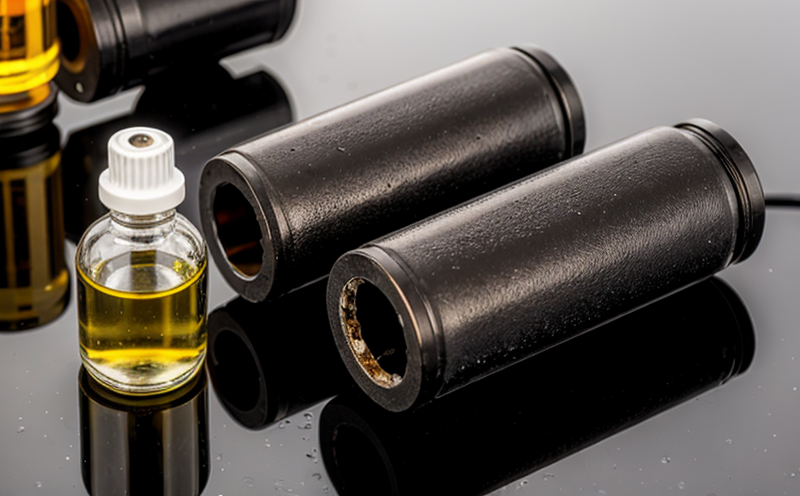APHA 5520E Oil and Grease Solid Phase Extraction Test in Water
The APHA (American Public Health Association) Standard Method 5520E is widely recognized for its accuracy and reliability in measuring oil and grease levels in water samples. This method employs solid phase extraction to isolate the target analytes from complex matrices, ensuring precise quantification of hydrocarbons present in environmental waters.
The significance of this testing lies not only in meeting regulatory compliance but also in understanding the impact of petroleum products on aquatic ecosystems. Hydrocarbons can originate from various sources including industrial discharges, accidental spills, and even natural seepage. By using the APHA 5520E method, laboratories are able to provide critical data that helps in environmental management, pollution control, and remediation efforts.
The methodology involves several key steps:
- Sample collection: Water samples should be collected according to standard procedures ensuring they represent the area of interest.
- Preparation: Samples are filtered through a glass fiber filter to remove particulates before extraction.
- Solid phase extraction (SPE): The sample is transferred to an SPE column pre-packed with sorbent. This step selectively retains oil and grease components while allowing water and other non-target compounds to pass through.
- Elution: Eluents are used to wash the retained hydrocarbons from the column into a collection vial.
- Detection: Extracted oils and greases are analyzed using infrared spectrometry or gas chromatography.
The APHA 5520E method is particularly useful in situations where there has been an accidental release of petroleum products. For instance, following a pipeline rupture or during the clean-up process after a tanker spill at sea. It allows for rapid assessment and quantification of hydrocarbon contamination, enabling quicker response times to mitigate damage.
Another important application area is in monitoring wastewater treatment processes. Oil and grease removal efficiency can be evaluated by measuring residual levels post-treatment. This information helps operators optimize their processes, ensuring compliance with discharge limits set by regulatory bodies such as the US Environmental Protection Agency (EPA).
The precision of this method makes it invaluable for research purposes too. Scientists studying the effects of petroleum hydrocarbons on aquatic life can rely on APHA 5520E results to correlate contamination levels with observed impacts. Understanding these relationships is crucial in developing strategies aimed at protecting sensitive ecosystems.
Scope and Methodology
The scope of the APHA 5520E method encompasses the determination of total oil and grease content in water samples using solid phase extraction. The target analytes include both petroleum hydrocarbons and other non-polar organic compounds that are typically present as emulsions or solvents in water.
The methodology described by APHA ensures consistency across different laboratories, making it a robust tool for regulatory compliance and quality assurance. It specifies the use of specific types of glass fiber filters and sorbents for SPE columns to ensure uniform results.
For accurate analysis, the following equipment is required:
- Infrared spectrophotometer or gas chromatograph for detection
- Solid phase extraction columns with appropriate sorbent (e.g., silica)
- Volumetric glassware and pipettes for precise measurements
- Air drying oven for sample preparation if necessary
The method allows for the measurement of total oil and grease in water at concentrations ranging from parts per million (ppm) to micrograms per liter (µg/L), depending on the sensitivity of the detection instrument used.
Acceptance criteria stipulate that samples must be analyzed within a specified time frame after collection to minimize degradation of the analytes. Additionally, blanks and replicates should be included in each batch analysis to account for potential interferences or errors.
Environmental and Sustainability Contributions
The APHA 5520E method plays a pivotal role in environmental protection by providing reliable data on hydrocarbon contamination. This information is essential for regulatory agencies, industry stakeholders, and environmental groups to make informed decisions regarding pollution prevention and control.
By accurately quantifying oil and grease levels, this test aids in the implementation of best management practices (BMPs) that can significantly reduce the risk of accidental releases into water bodies. For instance, improved tank maintenance programs or enhanced spill response protocols can be developed based on data obtained from APHA 5520E tests.
In terms of sustainability, the method contributes to long-term environmental stewardship by facilitating continuous monitoring and assessment of remediation efforts. Regular testing ensures that corrective actions are effective in reducing contamination levels over time.
Furthermore, the results generated through this standard method can support life cycle assessments (LCAs) for products containing hydrocarbons. LCAs help identify areas where improvements can be made to minimize environmental impacts throughout a product's lifespan from raw material extraction to disposal.
Use Cases and Application Examples
- Post-accident assessment: Following an oil spill, the APHA 5520E method can be used to quickly evaluate the extent of contamination in affected water bodies. This information is crucial for planning cleanup operations.
- Water treatment facility monitoring: Operators use this test to ensure that their treatments are effective at removing hydrocarbons from wastewater before it enters receiving waters.
- Aquatic ecosystem studies: Scientists can use the results of APHA 5520E tests to study how different levels of oil and grease affect aquatic organisms. This knowledge helps in developing protective measures for endangered species.
- Product development: Manufacturers of products containing hydrocarbons may employ this test during R&D phases to optimize formulations that minimize environmental impact.
- Regulatory compliance monitoring: Industries subject to stringent environmental regulations must regularly perform APHA 5520E tests as part of their quality assurance programs.
- Environmental remediation evaluation: During the cleanup phase, this test helps assess the effectiveness of implemented strategies and guide further actions needed for complete restoration.
- Oil spill response planning: Local governments use APHA 5520E data to establish baseline conditions before potential spills occur. This allows for more effective emergency responses if incidents do happen.
The versatility of the APHA 5520E method makes it indispensable across various sectors including oil and gas, chemical manufacturing, pharmaceuticals, and environmental consulting firms.





